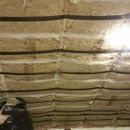XPS rigid insulation over flash and batt. Good idea?
Greetings,
I recently completed a flash and batt project using closed cell foam (3″) and roxul batts on the underside of my roof (~r35, ’20s craftsman, new england zone 5). These areas are not vented. I am looking for feedback on installing 1/2″ or 1″ XPS to the underside of the rafters to secure the batts in place, reduce air pockets between batts and spray insulation, and reduce thermal bridging from the rafters. I intend to hang drywall or wood panel to finish in the future. Any thoughts on the plus/minus of doing this?
Couple articles I came across note thermal bridging an issue in flash and batt: https://www.greenbuildingadvisor.com/article/the-flash-and-batt-method
and that interior rigid foam may not be a good idea in an unvented space: https://www.greenbuildingadvisor.com/article/walls-with-interior-rigid-foam
Any advice is greatly appreciated,
Ryan
GBA Detail Library
A collection of one thousand construction details organized by climate and house part










Replies
Hi Ryan,
The only minus I can think of is that it may restrict the ability for the fiberglass to dry effectively if it gets damp. You might be better off using a more vapor permeable board insulation, like EPS or perhaps Roxul Comfortboard. Both are considered more environmentally friendly than XPS, and EPS is also cheaper.
Edit: Be sure any EPS you use is unfaced. In the comments of the second article you linked (comment #2), Martin noted:
"Unfaced EPS that is 1/2 inch thick is fairly vapor-permeable (about 4 to 12 perms), so that's not much of an issue. If the EPS has a plastic or foil facing, of course, the permeance could be much lower."
Some foam will reduce thermal bridging and can be taped as an air barrier. But XPS isn't good for the environment. Unfaced EPS + Membrain would be better.
See point "9" below for the Class II requirement:
https://buildingscience.com/documents/digests/bsd-106-understanding-vapor-barriers
Jon, no need for the Membrain, there is 3" of ccSPF there already.
1" unface EPS would be fine as long as it gets drywall over it. You will be at about 5 perms. 1/2" eps is pretty fragile and not much cheaper.
No, the ccSPF that is there is in the wrong position to reduce the amount of interior moisture diffusing through to the Roxul.
As it stands you have about R20 closed cell foam with R15 rock wool? That's huge dew point control for zone 5. (Full dimension 2x6, right?)
If it weren't already installed going with R23 rock wool and 2" wide 1.5" polyiso + half inch CDX "Bonfiglioli strips" to deepen the rafters by 2", and staple on a layer of PERFORATED aluminized fabric radiant barrier to retain the CDX backed strips in areas that won't be finished space. The perforated RB typically runs about 5 perms, compared to less than 2 perms for 1" XPS.
https://www.finehomebuilding.com/membership/pdf/9750/021250059.pdf
Even though you've already installed the R15s, you might still consider 1" polyiso + half-inch CDX or 3/4" polyiso + 1x furring , if you're good with a batt knife and feel up to splitting R15s into a pair of ~1.75" batts. The 1" polyiso + 0.5' CDC adds R6.5 to the rafter edges without impeding drying (since the rafters can dry into the fiber), and the 1.5" of rock wool would add about R6.5 as well.
Full sheets of 1" XPS would add about R4.5-ish (the warranteed long term value), and would need to be covered with a timed ignition barrier to meet most fire codes, even in locations that won't be finished space. (Most inspectors would give a pass to edge strip foam.)
Thanks for all of the feedback, it certainly has me thinking more closely about the final steps. Is it suffice to say 3" of closed cell is insufficient in zone 5 to avoid condensation? Unfortunate if that's the case but I'm not going back now. If that is the case and given the stage of the project, it looks like I will go with EPS panels but I'm having a heck of a time finding unfaced EPS panels. Regarding the finish layer, are there wood products that I could use that would allow adequate vapor release? Thanks again.